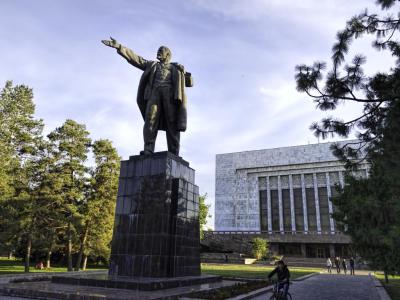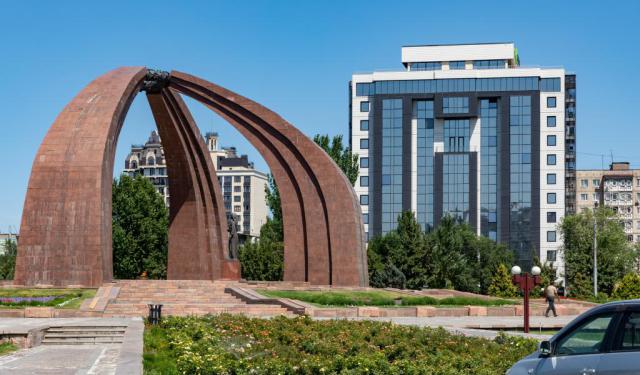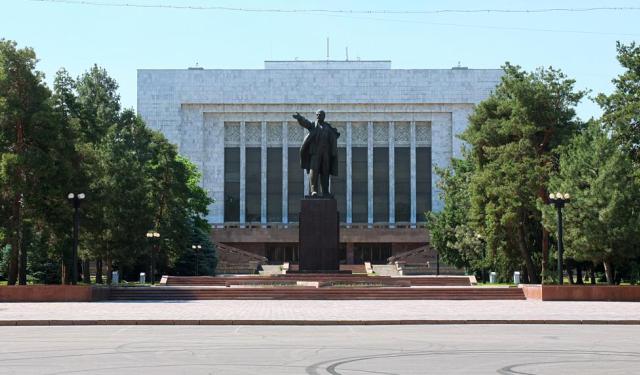
Lenin Monument, Bishkek
The Lenin Monument has a complex history that reflects the changing political landscape of the country. The statue was originally erected in 1984 to commemorate the 60th anniversary of the Kyrgyz Soviet Socialist Republic. Like many Lenin statues across the former Soviet Union, it was a symbol of the communist regime's influence and power.
Following the fall of communism in 1991, there was a wave of decommunization efforts, and Lenin statues were taken down in many cities. However, the Lenin statue in Bishkek remained in place until 2003, standing prominently in a square. At that time, plans were underway to renovate the square as part of the celebration of the 2,200th anniversary of Kyrgyz statehood.
The decision to relocate the Lenin statue near the Old Square sparked controversy and triggered a process of contestation. The government's explanations for the relocation were vague and inconsistent, leading to different interpretations and reactions from the public. The lack of clarity surrounding the decision fueled discussions and debates about the significance of the statue and its place in contemporary Kyrgyzstan.
The relocation of the Lenin statue in Bishkek can be seen as a reflection of the country's evolving identity and its attempts to navigate its post-Soviet era. It symbolizes the ongoing debate over the legacy of communism and the desire to redefine national symbols in the context of a new political and cultural landscape.
Following the fall of communism in 1991, there was a wave of decommunization efforts, and Lenin statues were taken down in many cities. However, the Lenin statue in Bishkek remained in place until 2003, standing prominently in a square. At that time, plans were underway to renovate the square as part of the celebration of the 2,200th anniversary of Kyrgyz statehood.
The decision to relocate the Lenin statue near the Old Square sparked controversy and triggered a process of contestation. The government's explanations for the relocation were vague and inconsistent, leading to different interpretations and reactions from the public. The lack of clarity surrounding the decision fueled discussions and debates about the significance of the statue and its place in contemporary Kyrgyzstan.
The relocation of the Lenin statue in Bishkek can be seen as a reflection of the country's evolving identity and its attempts to navigate its post-Soviet era. It symbolizes the ongoing debate over the legacy of communism and the desire to redefine national symbols in the context of a new political and cultural landscape.
Want to visit this sight? Check out these Self-Guided Walking Tours in Bishkek. Alternatively, you can download the mobile app "GPSmyCity: Walks in 1K+ Cities" from Apple App Store or Google Play Store. The app turns your mobile device to a personal tour guide and it works offline, so no data plan is needed when traveling abroad.
Lenin Monument on Map
Sight Name: Lenin Monument
Sight Location: Bishkek, Kyrgyzstan (See walking tours in Bishkek)
Sight Type: Attraction/Landmark
Guide(s) Containing This Sight:
Sight Location: Bishkek, Kyrgyzstan (See walking tours in Bishkek)
Sight Type: Attraction/Landmark
Guide(s) Containing This Sight:
Walking Tours in Bishkek, Kyrgyzstan
Create Your Own Walk in Bishkek
Creating your own self-guided walk in Bishkek is easy and fun. Choose the city attractions that you want to see and a walk route map will be created just for you. You can even set your hotel as the start point of the walk.
Bishkek Introduction Walking Tour
The capital city of Kyrgyzstan, Bishkek, is set against the picturesque backdrop of the snow-capped Tian Shan mountains at an altitude of 800 meters above sea level.
Compared to other major cities in Central Asia, Bishkek has a relatively short history. It was founded in 1825, as the Pishpek fortress, during the Russian colonization of the region. The fortress served as an administrative... view more
Tour Duration: 2 Hour(s)
Travel Distance: 3.7 Km or 2.3 Miles
Compared to other major cities in Central Asia, Bishkek has a relatively short history. It was founded in 1825, as the Pishpek fortress, during the Russian colonization of the region. The fortress served as an administrative... view more
Tour Duration: 2 Hour(s)
Travel Distance: 3.7 Km or 2.3 Miles
Soviet Era Architecture and Monuments Tour
While nomadic communities of yurt-living, horse-riding sheep herders are still thriving in the most remote valleys of Kyrgyzstan, the capital city of Bishkek shows a different facet of this Central Asian nation.
Built practically from scratch during the Soviet era, Bishkek experienced significant transformation in terms of urban planning and is packed to the rim with a well-preserved... view more
Tour Duration: 2 Hour(s)
Travel Distance: 3.6 Km or 2.2 Miles
Built practically from scratch during the Soviet era, Bishkek experienced significant transformation in terms of urban planning and is packed to the rim with a well-preserved... view more
Tour Duration: 2 Hour(s)
Travel Distance: 3.6 Km or 2.2 Miles


